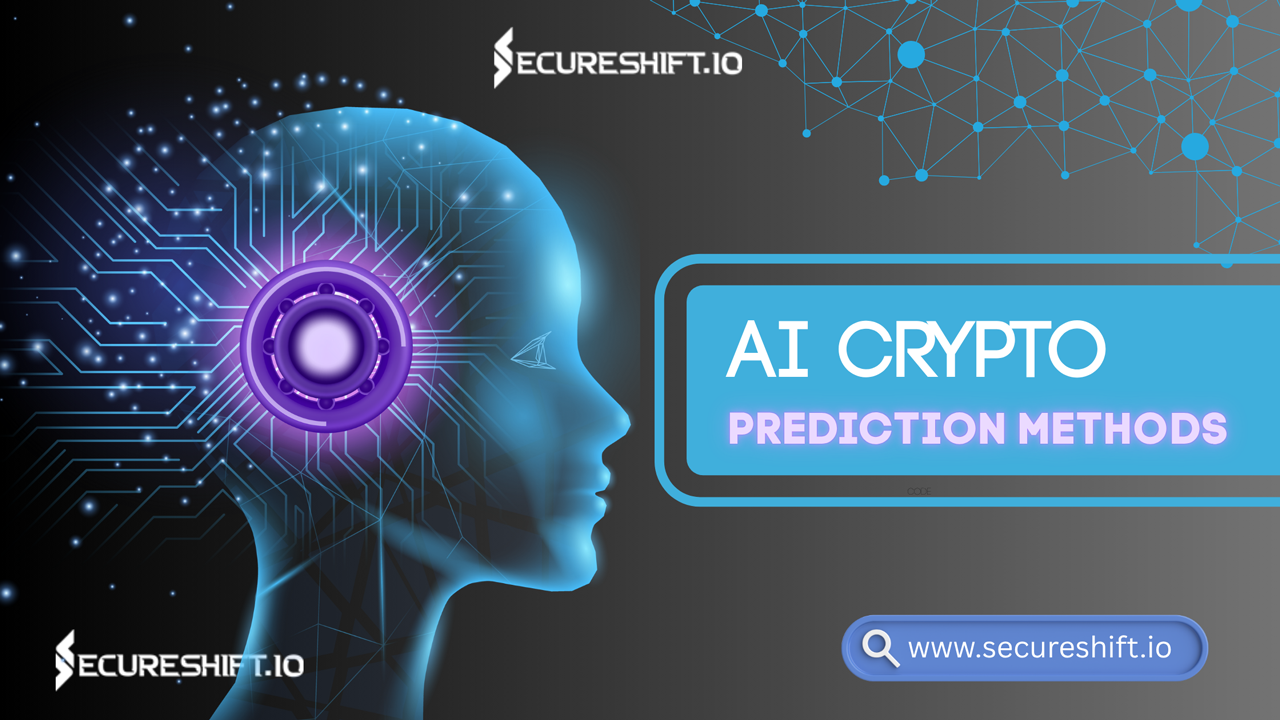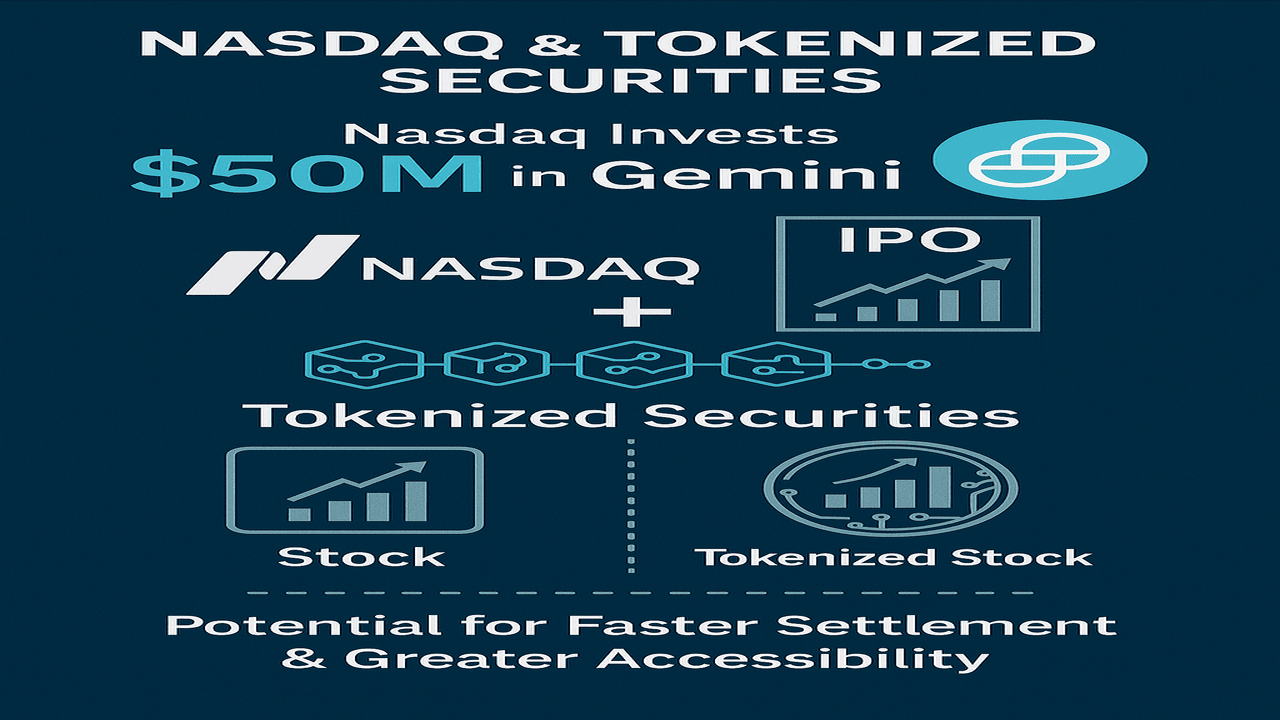
Top AI Crypto Prediction Techniques — 2025 Synopsis
In the past, the Secureshift team highlighted cryptocurrency projects that integrate blockchain technology with artificial intelligence (AI) or provide AI services, and they offered helpful tips on how to use AI bots to boost your trading. We'll go a step further this week and examine how well the state of AI technology currently in use can predict the future of the cryptocurrency market.
Table of Contents
- Important Takeaways
- Will AI's Crypto Prediction Skills Change the Game?
- Is it not possible to ask ChatGPT to forecast cryptocurrency prices?
- Top Platforms & Websites for Cryptocurrency Prediction
- Crypto Forecasts for the Future: What to Anticipate
- How to Obtain Predictions from AI
- In conclusion
- Frequently Asked Questions
Important Takeaways
Although AI tools for cryptocurrency prediction provide useful sentiment analysis and pattern recognition, they are not very good at predicting precise price targets. Instead of making exaggerated claims about forecasting accuracy, the most notable and successful cryptocurrency price prediction tools integrate technical analysis with on-chain metrics.
The best directional accuracy of the AI-powered prediction platforms currently available from Glassnode, Santiment, and TradingView's extensions is between 55 and 65%, which makes them helpful additions to trading strategies but not stand-alone solutions for crypto price forecasting. Rather than identifying precise entry and exit points, their main value is in information processing and risk management insights.
The secret to success is to use these tools' capacity to process enormous volumes of data while keeping a healthy dose of skepticism and seeing AI as one input among many. In order to deal with the inherent volatility and unpredictability of cryptocurrency and to interpret future predictions in context, the human element remains crucial.
Will AI's Crypto Prediction Skills Change the Game?
AI chatbots have caused a seismic shift in writing, planning, scheduling, research, and summarizing. They appear to be genuinely intelligent at times! These systems and applications have changed information and even decision-making, even though we are not yet there. Speaking of choices, isn't that what trading is all about?
AI has the potential to revolutionize any cryptocurrency trading approach. The nexus between cryptocurrency markets and artificial intelligence has become extremely popular, offering everything from fully automated trading systems to slightly improved entry points.
Additionally, there are AI crypto forecasting tools that promise to separate the complication of erratic markets. These systems promise an advantage in a market where information advantages quickly translate to profit by analyzing large amounts of historical data, monitoring social sentiment, and spotting patterns too subtle for human traders to notice.
The allure is clear: people must sleep, but cryptocurrency markets never do. Furthermore, AI is immune to FOMO and emotional trading decisions. It doesn't become avaricious during bull runs or panic sell during downturns. The ideal trading partner in theory.
Major cryptocurrency exchanges now provide prediction tools and AI-powered features to help traders make better decisions in response to market demand. The tools available to cryptocurrency traders have become more advanced, ranging from basic sentiment indicators to intricate predictive models that forecast price targets.
The question that everyone should be asking, though, is this: if these AI tools were truly capable of accurately predicting cryptocurrency prices, wouldn't their developers be billionaires rather than offering you their "secret formula"?
Most people are unaware of how complex the reality of using AI for crypto prediction is. True predictive power is still elusive for a number of significant reasons, even though AI is capable of analyzing historical data and spotting patterns.
Is it not possible to ask ChatGPT to forecast cryptocurrency prices?
Getting precise future price targets with the current AI chatbots should be as simple as creating a quick prompt for your preferred bot. Simply ask it what the outlook is for Bitcoin. Not at all!
According to direct testing, ChatGPT, Gemini, and Claude categorically decline to predict the price of cryptocurrencies. When asked for more specific information, outliers like Grok only cite information from other online sources, despite claiming that they have no explicit instructions against crypto forecasting.
A slide purportedly from an IBM presentation in 1979. The majority of AI chatbot default commands follow the same principle.
This behavior has a straightforward explanation. Things like a Bitcoin future price prediction are difficult for the majority of consumer-grade AI chatbots, which are likely the ones you use on a daily basis. Because a computer cannot be held responsible for giving bad financial advice, they are told not to give it so readily in case their predictions turn out to be incorrect.
So, how do media outlets and influencers obtain predictions about crypto AI? With certain inputs, AI chatbots can be overridden to defy their default commands. This is probably how the cryptocurrency predictions attributed to an AI are received. Is a cryptocurrency forecast they generate using these techniques even reliable, let alone accurate?
Top Platforms & Websites for Cryptocurrency Prediction
Platforms Driven by AI
Even though there are many cryptocurrency prediction sites available on the market, not all AI platforms are the greatest resources for helping you make trading decisions. Let's go over some that are worth seeing.
First and foremost, Coin360 is notable for its advanced machine learning algorithms that have been trained on more than five years' worth of market data. Although its premium tier may seem pricey to novice traders, users commend its clear interface and simple cryptocurrency price forecasts. Its openness regarding prediction confidence levels, which the majority of its rivals conveniently conceal, is what sets it apart.
Second, among serious traders, TradingView's Trend Prophet extension has become a favorite. It focuses on determining probable reversal points and trend strength rather than making audacious price predictions. By comparing your analysis with that of other traders, the community feature gives the AI insights a human touch.
Thirdly, Santiment adopts a completely different strategy. Its AI evaluates on-chain activity, developer contributions, and social volume to assess and predict the sentiment of the cryptocurrency market rather than making direct price predictions. For starters, their "Network Value to Transactions" ratio has shown a surprising ability to pinpoint market peaks and troughs.
How can one assess the state of the cryptocurrency market without breaking the bank? TradingView and CoinCodex's free tiers lack the advanced AI models found on premium platforms, but they do provide some automated pattern recognition and basic technical analysis. The Crypto Fear & Greed Index on Alternative.me offers free crypto outlook analysis, but serious traders soon outgrow these constrained features and their broad insights.
AI Prediction for Bitcoin
Is it possible for an AI to predict the exact outcome for Bitcoin? Of course it could try. To what extent are those AI forecasts for Bitcoin correct? In actuality, the outcomes are, at best, inconsistent.
Because of its dominant position in the market, Bitcoin is both easier and harder to predict. simpler due to the availability of a great deal more data, including historical trends, on-chain metrics, and trading volume. More difficult because even highly advanced AI forecasts find it difficult to account for the macro factors that affect the future value of Bitcoin.
Platforms such as Glassnode monitor whale movements and exchange flows by analyzing Bitcoin's on-chain data using machine learning. Their models identify possible pressure points where big moves might happen rather than offering precise price targets and forecasts for Bitcoin.
The neural network used by BitcoinWisdom to power the price prediction tool claims 68% accuracy in predicting the future direction of the price of bitcoin over 24-hour periods, not specific price values. Even though it only forecasts Bitcoin's future course, it is still preferable to speculating, but it is by no means the crystal ball that many people wish for.
There are currently no trustworthy forecasts for the factors that will affect Bitcoin. Even the most advanced systems were unable to forecast Bitcoin's explosive rise to $69,000 during the 2021 bull run. They also failed to see the subsequent crash, which highlights a basic flaw in AI: it is very good at spotting historical trends, not forecasting novel market conditions.
Forecast for Altcoins
So, can AI be useful in the extremely unstable altcoin world? Similarly, yes and no. What's the matter with predictions for altcoins? A word of caution before we list the options.
Even highly advanced AI finds it difficult to overcome the additional difficulties that altcoin prediction poses. The risk of manipulation increases with lower trading volumes. Models cannot learn from new tokens because they lack historical data. Furthermore, price swings that no algorithm can ever predict can be brought on by fundamental changes like protocol upgrades or partnership announcements.
In any case, CoinGecko's Sentiment Tracker analyzes social media conversations about smaller tokens using natural language processing, but it also makes no specific cryptocurrency price predictions. Potential breakout coins have been successfully identified using this sentiment analysis prior to significant price movements.
LunarCrush then goes one step further by giving altcoins "Galaxy Scores" determined by social engagement metrics. Their internal testing shows that these scores correlate with price movements roughly 62% of the time, even though they do not directly predict altcoin prices.
Token Metrics uses AI to assess tokenomics, team experience, and project roadmaps, with an emphasis on the fundamentals rather than technical patterns. Their strategy steers clear of the dumb mistake of making precise altcoin price predictions in favor of longer-term quality evaluations.
The harsh reality is that even the most advanced AI systems have trouble predicting altcoin prices over extended periods of time. Instead of using crypto predictors as the only prediction engine, the most successful traders use them as one input among many.
Crypto Forecasts for the Future: What to Anticipate
Which AI systems are currently making predictions about cryptocurrency? The truth is that the majority of trustworthy AI systems won't actually forecast a specific price, such as "Bitcoin will reach $110,000 by April."
They do offer trend analysis, pattern recognition, and probability ranges. AI systems of today are detecting heightened volatility in the main cryptocurrencies, with contradictory signals that reflect the unpredictability of the market. While some warn of deteriorating on-chain metrics, others identify accumulation patterns that historically precede upward movements.
Short-term sideways movement with increased sensitivity to macroeconomic factors outside the crypto ecosystem is the consensus view, if you can call it that. Institutional flow data, which indicates smart money positioning more conservatively than retail sentiment would imply, is of particular interest to AI systems.
In other words, when someone asserts that AI predicts that a cryptocurrency asset will reach a certain price, they are either misinterpreting the nature of these systems or purposefully misrepresenting probability-based analysis as absolute.
Types of Predictions
Making AI generate price targets is challenging, and even then, their accuracy is debatable. Don't expect them to make predictions about cryptocurrencies based on today's news. However, the best way to use these is to obtain different kinds of market insights that support various trading strategies.
Pattern recognition, for instance, finds chart formations that have previously preceded particular movements. Instead of forecasting that "ETH will hit $5,000," these models may indicate that in 70% of past instances, the current pattern has come before a 15% increase in value.
Sentiment analysis looks at forum discussions, news sources, and social media to determine how the market is feeling. This strategy works well for altcoin trading and/or in volatile markets to identify maximum fear close to bottoms or peak euphoria prior to corrections.
Network health metrics, which examine blockchain activity instead of just price action, are another useful analysis tool. Price declines that technical analysis alone might overlook are frequently preceded by declining active addresses, transaction counts, or fee revenue.
Finally, divergence detection detects when price movements of cryptocurrencies deviate from underlying metrics, such as when prices increase while the number of active users decreases, which frequently indicates unsustainable conditions.
The time horizon is crucial in any event. For very short-term cryptocurrency predictions (minutes to hours) and longer-term trend analysis (months), AI typically does fairly well. However, it has trouble with the intermediate term, where random market noise dominates the signal.
Precision
How accurate are predictions made by crypto AI, then? Additionally, it is not as impressive as marketing claims would suggest.
According to reports, the best systems can accurately predict up or down movements with directional accuracy of 55–65% over brief periods of time. If it's 50%, that's better than random guessing, but it's still far from perfect. Accuracy drastically decreases for more precise price goals.
Even more telling is the fact that accuracy rates drastically drop when the market regime shifts. When conditions change to a bear market or sideways trend, AI that did well in a bull market frequently performs horribly. It is more related to the learning dataset and less to recency bias.
In reality, hindsight bias is the type of bias that permeates this field. What are their best predictions for cryptocurrency? Most likely coincidences. Many platforms conveniently leave out all the misses while promoting the best, selectively chosen examples where their predictions came true. Few provide thorough accuracy statistics that would enable appropriate assessment.
Market manipulation poses a significant challenge, which is another wrench in the works, this time from the cryptocurrency industry itself. Large holders have the ability to cause price movements in thinly traded altcoins that defy all logical forecasts based on fundamentals or historical patterns.
The most trustworthy AI systems are aware of these drawbacks, prioritizing risk management over certainty—even if that isn't what customers desire—and providing probability ranges rather than exact forecasts.
For instance
So far, there has been enough discussion. The possibilities and constraints of AI prediction are clearly illustrated by a few real-world examples.
When Bitcoin fell below $26,000 during the market correction in May 2023, Santiment's NVT model identified it as "severely undervalued." As cryptocurrency prices rebounded, those who purchased using this coin prediction saw gains of about 15% in just three weeks—a modest success.
In comparison, the AI model developed by CryptoQuant projected that Bitcoin would find support at $52,000 during the December 2021 crash. It kept dropping to $42,000, showing how even highly advanced models falter in unheard-of market circumstances.
In August 2021, LunarCrush assigned Solana a "Galaxy Score" of 75/100 for altcoins, indicating a high level of optimism. In the months that followed, the token increased by 500%. Nevertheless, despite on-chain metrics displaying alarming trends, the same system was unable to forecast SOL's demise during the FTX crisis.
Using wallet clustering analysis, IntoTheBlock's prediction model accurately predicted in April 2023 that Ethereum would encounter resistance at $2,000. AI's ability to analyze specific on-chain metrics instead of making general price predictions is demonstrated by the accuracy of this coin prediction, which was within $50 of the actual reversal point.
Despite the lack of AI chatbots at the time, almost all algorithmic trading systems and quantitative models were unable to forecast Bitcoin's 50% one-day decline during the COVID-19 pandemic in March 2020. This demonstrates the basic drawback of both earlier and modern AI: while these systems extrapolate from historical trends, "black swan" events also influence the cryptocurrency markets.
How to Obtain Predictions from AI
Getting on AI Platforms
Are you prepared to test out AI-powered crypto analysis for yourself now that you have a better idea of what AI tools can actually do? Here's how to get started on overhyped platforms without wasting time or money.
The majority of premium platforms provide free trials for a week or two. Use these to try out different services without committing. With paid tiers that unlock the more specialized AI features, CryptoQuant, Glassnode, and Santiment all offer restricted free access to their basic metrics.
The cost of crypto projection services' subscription models varies greatly. Professional-grade services can cost more than $200 per month, while entry-level plans usually cost between $30 and $50. The difference in features, especially the ability to access historical backtesting data that aids in assessing the AI's real performance, is just as significant as the price increase.
A tip: TradingView is arguably the most affordable paid service for novices. Although their premium tiers offer more real-time data and advanced indicators, their basic plan gives users access to community-created scripts that use machine learning.
Free services that claim to be the best website for predicting cryptocurrency prices? Stay put, it's too good to be true. The cost of creating and maintaining the complex AI models and data feeds needed for even somewhat trustworthy analysis is high. Free platforms frequently mine your data, push particular tokens, or just make arbitrary guesses under the guise of "AI predictions."
Sources of Data
The data that these systems are fed determines how accurate the AI predictions are. That's not what you would agree to, would you? Garbage in, garbage out. The majority of platforms integrate several crucial data streams.
The basis is made up of price and volume data, which are usually taken from several exchanges to guarantee accuracy. Reputable platforms remove trading that might distort forecasts and filter out anomalies.
Traditional markets do not offer the insights that on-chain metrics do. In addition to price action, wallet movements, mining difficulty, hash rate, and transaction counts provide insight into the health of the network. Platforms that focus on these metrics include Glassnode and CryptoQuant.
Market mood can be measured with the use of social sentiment data gathered from Twitter, Reddit, Discord, and Telegram. Businesses such as LunarCrush and Santiment use natural language processing to analyze millions of posts every day in order to identify changing sentiment before it affects prices.
Code commits and the rate of project development are monitored by developer activity metrics. Price reductions are frequently preceded by declining development as teams lose funding or momentum.
Institutional movements are tracked by exchange inflow/outflow data. Large transfers from exchanges to cold storage frequently signify significant players' long-term accumulation.
However, AI still has trouble contextualizing news and regulatory developments correctly. Although some of the best platforms integrate API feeds from prominent crypto news sources, they have trouble interpreting regulatory news in a nuanced way.
Legitimate AI platforms are distinguished from glorified chart readers by their advanced handling of these data sources. Before entrusting any platform with your trading decisions, it wouldn't hurt to pose the difficult questions regarding data sources.
Comprehending AI Forecasts
Therefore, even the greatest crypto analysis website would not give you a quick solution and, more importantly, would not relieve you of the cognitive load. How can you apply these AI insights in practice without making common mistakes? Everything discussed thus far can be summed up in a sensible strategy used by seasoned traders.
Recognize what you're looking at first. Predictions of various kinds have various uses. Sentiment indicators are very good at predicting future market peaks and troughs. When it comes to entry and exit points within established trends, technical pattern recognition performs better. Early warning of fundamental changes is provided by on-chain analysis.
Never depend on just one platform or indicator. Compare and contrast forecasts from various sources. Convergence is more significant than any single prediction when various analysis techniques independently arrive at similar conclusions. Similarly, AI should be used as one of many inputs rather than as the sole decision-maker. Integrate AI insights with your personal knowledge of risk tolerance, general economic factors, and market fundamentals.
Did we mention how important time frames are? While predictions for this week's cryptocurrency become more dubious, AI predictions for the next day may be fairly accurate. Keeping this in mind, adjust the cryptocurrency price prediction time frame to your preferred trading approach.
Recognize the difference between certainty and probability. Reputable websites describe forecasts as probabilities rather than absolutes. When a system displays a "75% chance of upward movement," it indicates that it will be incorrect one out of every four times.
Watch out for confirmation bias, which is the propensity to discount cryptocurrency predictions that conflict with your current beliefs and to favor those that support them. Keep track of both successes and failures to fairly assess how well each platform performs for your particular requirements.
When trading based on AI cryptocurrency price predictions, start with small position sizes until you've tested their dependability with your own money at stake. Real-world outcomes in your actual trading strategy are the only thing that can replace any backtested performance metric.
All things considered, AI is a tool that assists in identifying opportunities that merit more research rather than acting as a crystal ball for cryptocurrency predictions. When using these systems to process more information than any human could evaluate alone, it is recommended to exercise healthy skepticism.
In conclusion
With their ability to analyze large datasets, spot trends, and eliminate emotional bias, AI tools for cryptocurrency trading are incredibly potent. The idea of algorithms that can reliably forecast prices or the timing of the next cryptocurrency cycle is still just that—a dream. Instead of providing the revolutionary edge that marketing promises, these systems only produce modest accuracy gains, and their true value is in risk management rather than identifying precise entry points.
Was the article enlightening to you? Check out the Secureshift blog for more of that goodness! Please share your opinions in the comments section or on Facebook, X, and Telegram. Don't forget to follow.
Frequently Asked Questions
Which AI cryptocurrency is the best to invest in?
Do you want to know which cryptocurrency works best with AI rather than the other way around? If you're looking for a cryptocurrency that uses artificial intelligence, the Secureshift team has reviewed some promising AI coins and offered advice on which ones to look into and purchase.
Which AI is best for predicting cryptocurrency?
Which choice is the best for making accurate predictions about cryptocurrency? The best cryptocurrency website for market sentiment analysis is LunarCrush, while CryptoQuant and IntoTheBlock are the most accurate for short-term trend direction (55–65% accuracy). None regularly generate precise and highly accurate cryptocurrency price predictions.
Which AI tool is the best for 2025 cryptocurrency investing?
Rather than offering a precise coin price prediction, AI will be most useful to traders in identifying risk factors, detecting changes in the market regime, and processing large data sets. Combine risk management, fundamental analysis, and AI insights to forecast cryptocurrencies. The most trustworthy analysis is provided by platforms such as Glassnode, Santiment, and TradingView's Prophet extension, which combine technical patterns, social sentiment, and on-chain metrics instead of predicting a particular token price.
Which AI cryptocurrency prediction for 2030 is most likely to come true?
What will happen to predictions about cryptocurrencies in five years? Anticipate AI to be particularly good at sentiment analysis and pattern recognition, but not at forecasting black swan events or precise price targets. Although technology will advance, human judgment will still be necessary when making trading decisions.
Start a Cryptocurrency exchange Try our crypto exchange platform click here
Disclaimer: It is important to note that the content of this article does not constitute financial or investment advice. The views expressed herein are solely those of the author and should not be interpreted as specific recommendations for trading or investing. Readers and visitors to the website are encouraged to explore various perspectives and familiarize themselves with relevant local regulations prior to engaging in cryptocurrency investments. We do not guarantee the reliability or accuracy of the information presented.



